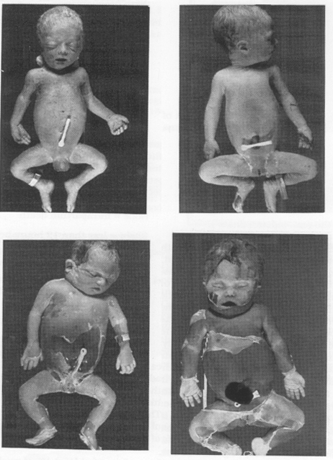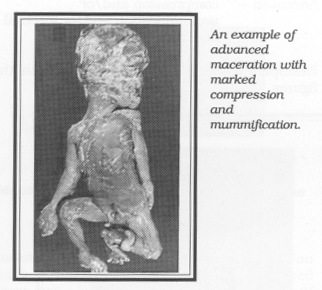Conner's Maceration is not consistent with a 3.5 month intrauterine retention
Warning: This article includes very graphic pictures.
The State convicted Scott on the theory that Scott put a pregnant Laci in the Bay on December 24. Conner was found over 3 1/2 months later, on April 13, 2003.
Dr. Brian Peterson described Conner's delicate condition:
External Exam:
Conner was decomposing, in general terms. He weighed 1160 grams (approximately 2. 5 pounds). A crown-of-head measurement could not be taking because the head was collapsing. Crown-heel length was 48 centimeters (approximately 19 inches). Based on these measurements, Conner could have reached full-term. The skin was quite soft, in keeping with maceration, an effect on tissue soaking in fluid. No vernix on the body. The bones in the skull were overriding, which happens as the brain liquefies. There was a tear near the right shoulder that exposed skeletal muscle and the structures beneath. The tear extended onto the abdominal wall and portions of the small and large intestines protruded through the tear. There was no scalloping, no curved marks around the edges. Concluded it was simply from tissue falling apart or being pulled apart due to tidal action, it wasn't due to animal feeding. A portion of the colon protruded from the anus. There was a portion of the umbilical cord present, measuring a half centimeter (less than a 1/4 inch), and the edge was ragged, like it fell apart or pulled apart. It was not cut.
Internal exam:
There were no specific changes of either congenital abnormality or disease. The organs, in general, were soft and liquefied, in keeping with decomposition. The spleen and kidney could not be weighed because they were liquefied. There was more liquefaction inside the right side of the chest as opposed to the left because of the tear. The changes were simply the result of decomposition and immersion.
Several studies on stillborn babies have been completed "to determine how accurately the time of fetal death can be predicted from the extent of external maceration in a stillborn fetus" (Genest, David R. M.D. and Don B. Singer, M.D, "Estimating the Time of Death in Stillborn Fetuses: III. External Fetal Examination; a Study of 86 Stillborns." Obstetrics & Gynecology. 80 (4) (Oct 1992). 593-600. Hereafter cited as Genest). In Genest, "autopsy photographs of 86 stillborns with well-timed deaths were studied retrospectively (593).
Genest concluded that "eight gross features correlated reasonably well with specific death-to-delivery times in terms of sensitivity, specificity, and positive predictive values of 0.8000 (80%) or more" (Table 2, 595).
Note: Desquamation is the shedding of the outer layer of skin. Body zones are: scalp, face, neck, chest, abdomen, back, arms, hand, leg, foot, and scrotum.
| Gross Feature |
Time from Death to Delivery at least |
| Areas of desquamated skin measuring 1 cm or more in diameter | 6 hours |
| Cord discoloration (brown or red) | 6 hours |
| Desquamation involving the skin of the face, back, or abdomen | 12 hours |
| Desquamation of 5% or more of the body surface | 18 hours |
| Desquamation involving 2 or more of the 11 body zones | 18 hours |
| Brown or tan discoloration of the skin, usually involving the abdomen | 24 hours |
| Moderate or severe desquamation | 24 hours |
| Mummification (any) | 2 weeks |
Genest did not provide pictures of all 86 stillborns, but did provide two of particular interest to this discussion. The first is of a 30-week fetus who died between 288-456 hours (12-19 days) before birth. "Severe desquamation is seen, consistent with at least 24 hours of intrauterine retention; mummification is absent, suggesting a retention of less than 2 weeks (336 hours)" (599). The second is a "24-week fetus who died between 8-12 weeks before birth. The skin is tan in color and extensive mummification is seen, consistent with at least 2 weeks (336 hours) of intrauterine retention after fetal death" (599).
Liquefaction of internal organs
Liquefaction of internal organs was not considered by Genest because it is not an external observation. However, Richard M. Pauli, M.D. does list liquefaction as an advance stage of maceration ("Maceration and the Timing of Intrauterine Death" at WISPP).
Pauli identifies the stages of maceration, with a sample picture of each
1. None
2. Slight -- skin
slippage, rare bullae, little (e.g. scrotum only or single spots of skin loss
elsewhere) or no denudation
3. Mild -- focal denudation of multiple regions without other changes
4. Moderate-- generalized skin maceration/ denudation but without significant compressive changes
5. Advanced -- compression and/or mummification and/or internal liquefaction


Pauli cited Genest as a much needed study to assess "fetuses in whom timing of death was well-documented." Pauli noted that six of Genest's "measures are applicable to the scale used by WiSPP.
| Feature | Interval between death and delivery |
| Skin desquamation of > or =1 cm | > or = 6 hours |
| Skin desquamation involving the face, back and/or abdomen | > or =12 hours |
| Skin desquamation involving at least 5% of body surface | > or = 18 hours |
| Change of skin coloration to tan or brown | > or = 24 hours |
| Generalized skin desquamation | > or = 24 hours |
| Mummification | > or = 14 days |
The resulting WiSPP interval time for each stage is:
None = intrapartum death
Slight = less than 12 hours between death and delivery
Mild = about 12-24 hours between death and delivery
Moderate = one to a few days between death and delivery
Advanced = more than a few days between death and delivery.
Conclusion
These studies show the very rapid changes a stillborn fetus undergoes in the womb of a living woman. Conner's macerated condition is not consistent with a 3.5 month intrauterine retention period. He did not have severe desquamation and he was not compressed or mummified.
Furthermore, retention in the womb of a dead mother, who is undergoing her own decomposition, would most certainly accelerate the rate of change.
Experts in the field of stillborn fetal maceration should have been consulted to determine the maximum time Conner could have been retained in Laci's womb after he died. Such experts still can provide valuable information, as the autopsy pictures are preserved.